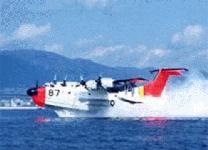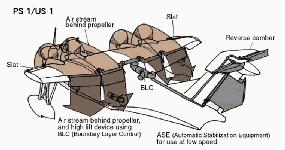FAS |
Military |
DOD 101 |
Systems |
Aircraft |
ROW ||||
Index |
Search |
Join FAS




US-1 / PS-1
The US-1A is in service with Japan's Maritime Self-Defense Forces, and is active in search and rescue far from Japan's shores in the Pacific Ocean and the Sea of Japan. A characteristic of this aircraft is that its superior performance permits it to land on rough seas and continue its rescue activities. Moreover, it has a long range and can search over a wide area for a long time. In addition, since it is an amphibian that can land on either land or sea it can rescue people at sea and on remote islands that do not have airstrips, then land at an airstrip on land so that the victim(s) can be rapidly transferred to a hospital. Since this aircraft's first rescue at sea, from a Greek vessel in 1976, until March 1999, this model aircraft has made 548 rescues during which 550 people were rescued. For Japan based on the exclusively defense-oriented policy, it is extremely important to carry out constant warning and surveillance over Japanese territory and its surrounding airspace and waters. The Japan Maritime Self-Defense Force [JMSDF] carries out constant warning and surveillance operations over vessels moving in the waters surrounding Japan, through patrol aircraft and vessels, and engages in collecting information on movements and equipments of foreign vessels. In case of emergency, it is important to search and rescue the crew of aircraft or submarines in distress from the viewpoint of respecting for their lives and maintaining their morale. The JMSDF possesses rescue amphibian, US-1A for the maritime rescue operations, rescue helos for the aerial rescue in the vicinity of the air-base, and submarine rescue vessel for rescuing submarines. Since 1960 ShinMaywa Industries, Ltd. has developed STOL technology which makes it possible for aircraft to operate in rough seas in which operation was previously impossible. In developing the PS-1/US-1, a UF-1 supplied by the United States Navy to the Japanese Defense Ministry was modified and a 3/4-size model called the UF- XS was produced, and tests of the performance of the hull in waves, of the roll damping mechanism and of the high lift mechanism were conducted. Shin Meiwa began working on the SS-2 after winning a contract in 1966, and the first of two prototypes flew on 05 October 1967. After testing the production aircraft entered service with the JMSDF as the PS-1. In 1970 an amphibian version was designed and first flown on 16 October 1974. The plane's first land take-off occurred on 03 December 1974. The PS-1 was subsequently redesignated the US-1 to reflect a change in mission from anti-submarine warfare to at-sea rescue, and production of the US-1A STOL Search and Rescue Amphibian is continuing to this day. This is the only large flying boat in production today. The US-1A amphibian uses its superior performance, including the ability to land on rough seas, in such operations as search and rescue at sea and emergency transport to isolated islands. In addition, it is expected to find application as a firefighting aircraft and in transport systems to isolated islands which lack airstrips. The aircraft is fitted with a T-tail unit, retractable beaching chasis, a single-step hull, and wing-mounted stabilizing floats. The aircraft is powered by four General Electric turboprop engines and a fifth gas turbine engine is located inside the fuselage. This fifth engine provides compressed air for the aircraft's STOL boundary control system. Shin Maywa Industries Ltd. (formerly the Shin Meiwa Industry Company Limited) started in 1918 with the limited partnership Nippon Aircraft Manufacturing, the first aircraft manufacturer in Japan. The company then became the Aircraft Division of Kawanishi Machine Manufacturing Company, and in 1928 went independent as Kawanishi Aircraft Company Limited. Until the end of World War II Kawanishi built 2,862 aircraft, including a number of flying boats. With the large increases in size of land-based aircraft during World War II, the need for flying boats decreased, and flying boats disappeared from the commercial airlines.Specifications | |
| Country of Origin | |
| Builder | |
| Role | |
| Similar Aircraft | |
| Wing Span | |
| Length | |
| Height | |
| Weight | |
| Engine | |
| Maximum speed | |
| Cruising speed | |
| Range | |
| Service Ceiling | |
| Armament | |
| Crew | |
| Cost | |
| User Countries | |



Sources and Resources
FAS |
Military |
DOD 101 |
Systems |
Aircraft |
ROW ||||
Index |
Search |
Join FAS
http://www.fas.org/man/dod-101/sys/ac/row/us-1.htm
Maintained by Robert Sherman
Originally created by John Pike
Updated Tuesday, September 21, 1999 10:18:15 AM